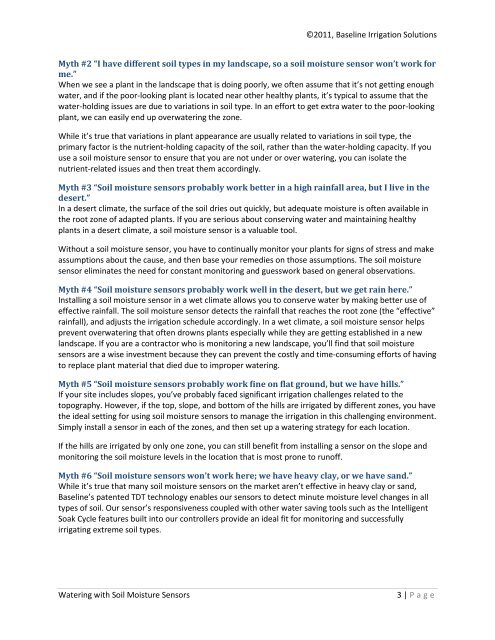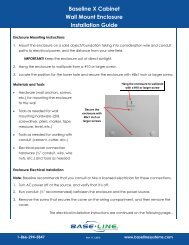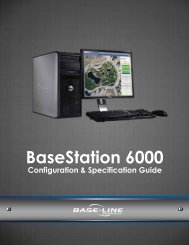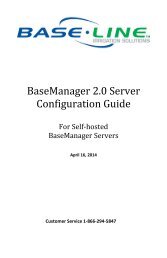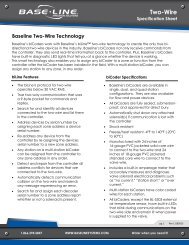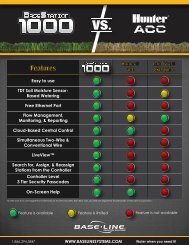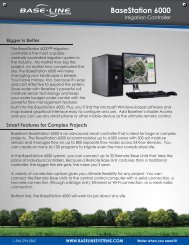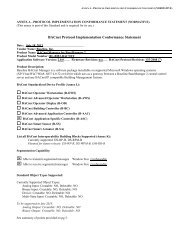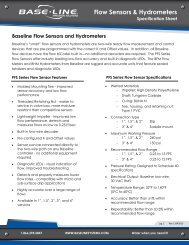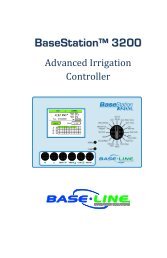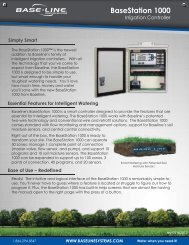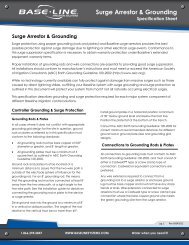Watering with Soil Moisture Sensors - Baseline Systems
Watering with Soil Moisture Sensors - Baseline Systems
Watering with Soil Moisture Sensors - Baseline Systems
Create successful ePaper yourself
Turn your PDF publications into a flip-book with our unique Google optimized e-Paper software.
©2011, <strong>Baseline</strong> Irrigation SolutionsMyth #2 “I have different soil types in my landscape, so a soil moisture sensor won’t work forme.”When we see a plant in the landscape that is doing poorly, we often assume that it’s not getting enoughwater, and if the poor-looking plant is located near other healthy plants, it’s typical to assume that thewater-holding issues are due to variations in soil type. In an effort to get extra water to the poor-lookingplant, we can easily end up overwatering the zone.While it’s true that variations in plant appearance are usually related to variations in soil type, theprimary factor is the nutrient-holding capacity of the soil, rather than the water-holding capacity. If youuse a soil moisture sensor to ensure that you are not under or over watering, you can isolate thenutrient-related issues and then treat them accordingly.Myth #3 “<strong>Soil</strong> moisture sensors probably work better in a high rainfall area, but I live in thedesert.”In a desert climate, the surface of the soil dries out quickly, but adequate moisture is often available inthe root zone of adapted plants. If you are serious about conserving water and maintaining healthyplants in a desert climate, a soil moisture sensor is a valuable tool.Without a soil moisture sensor, you have to continually monitor your plants for signs of stress and makeassumptions about the cause, and then base your remedies on those assumptions. The soil moisturesensor eliminates the need for constant monitoring and guesswork based on general observations.Myth #4 “<strong>Soil</strong> moisture sensors probably work well in the desert, but we get rain here.”Installing a soil moisture sensor in a wet climate allows you to conserve water by making better use ofeffective rainfall. The soil moisture sensor detects the rainfall that reaches the root zone (the “effective”rainfall), and adjusts the irrigation schedule accordingly. In a wet climate, a soil moisture sensor helpsprevent overwatering that often drowns plants especially while they are getting established in a newlandscape. If you are a contractor who is monitoring a new landscape, you’ll find that soil moisturesensors are a wise investment because they can prevent the costly and time-consuming efforts of havingto replace plant material that died due to improper watering.Myth #5 “<strong>Soil</strong> moisture sensors probably work fine on flat ground, but we have hills.”If your site includes slopes, you’ve probably faced significant irrigation challenges related to thetopography. However, if the top, slope, and bottom of the hills are irrigated by different zones, you havethe ideal setting for using soil moisture sensors to manage the irrigation in this challenging environment.Simply install a sensor in each of the zones, and then set up a watering strategy for each location.If the hills are irrigated by only one zone, you can still benefit from installing a sensor on the slope andmonitoring the soil moisture levels in the location that is most prone to runoff.Myth #6 “<strong>Soil</strong> moisture sensors won’t work here; we have heavy clay, or we have sand.”While it’s true that many soil moisture sensors on the market aren’t effective in heavy clay or sand,<strong>Baseline</strong>’s patented TDT technology enables our sensors to detect minute moisture level changes in alltypes of soil. Our sensor’s responsiveness coupled <strong>with</strong> other water saving tools such as the IntelligentSoak Cycle features built into our controllers provide an ideal fit for monitoring and successfullyirrigating extreme soil types.<strong>Watering</strong> <strong>with</strong> <strong>Soil</strong> <strong>Moisture</strong> <strong>Sensors</strong>3 | P age


